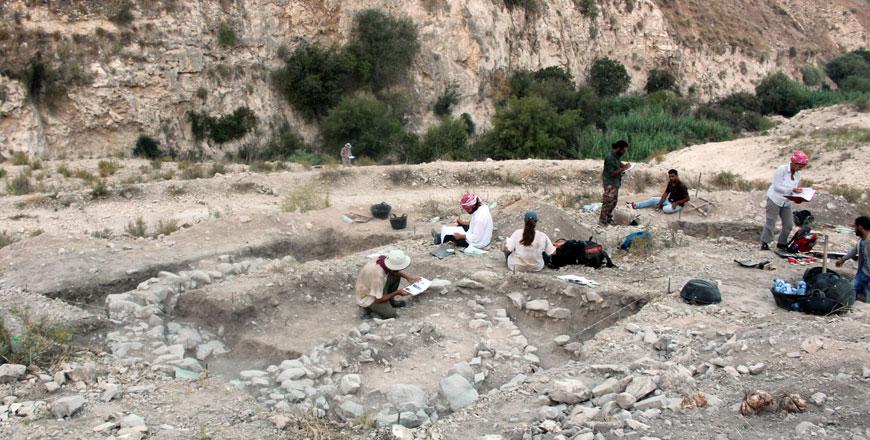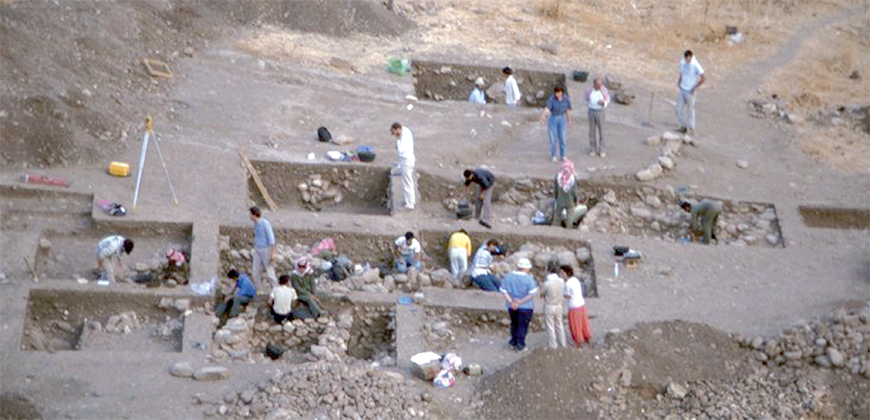You are here
Wadi Quseiba excavations offer clues to Yarmoukian lifestyle
By Saeb Rawashdeh - Sep 15,2019 - Last updated at Sep 15,2019

The Wadi Quseiba team excavating an oval-shaped Yarmoukian building in 2018 (Photo courtesy of Kevin Gibbs)
AMMAN — Excavations at a Late Neolithic site in north-western Jordan revealed the existence of an agrarian society in which pottery held a key role, a Canadian archaeologist has said.
Kevin Gibbs, who is affiliated with the University of California, Berkeley, has excavated the Late Neolithic site in north-western Jordan called WQ117 in Wadi Quseiba, along with a colleague from the University of Toronto.
According to Gibbs, some sites from the Late Neolithic period, which lasted from about 6500 to 5200 BC, are quite small and difficult to find, which is why there are still many gaps in the understanding of the Late Neolithic.
“Another problem is that many archaeologists prefer to study the early part of the Neolithic, when people first started farming, but a lot of interesting things happened during the Yarmoukian period,” Gibbs said, referring to the earliest phase of the Late Neolithic.
The changes in settlement and technology that happened during the Yarmoukian period are part of the project’s research.
Regarding the pottery from the Yarmoukian period, it typically has a particular kind of decoration that was incised into the clay with a sharp tool, the scholar told The Jordan Times in a recent e-mail interview.
“It’s sometimes called a herringbone pattern because it looks a bit like the bones of a fish. We found lots of this pottery at WQ117,” he said.
Many of the artifacts from the site are associated with these features and some Yarmoukian sites have small figurines of people made of stone or clay, Gibbs elaborated, adding that the researchers found a couple of broken fragments of these rare objects at WQ117 in Wadi Quseiba.
“People also made stone tools at the site. Metal tools weren’t invented yet,” Gibbs said.
According to Gibbs, it seems that WQ117 was only occupied during the Yarmoukian period and not before or after. The scholar added that, apart from noting the similarities in material culture with other sites in the region, the site can also be dated using radiocarbon dating.
“We have dates putting the occupation around 6200-6000 BC but it’s possible that Yarmoukian people started living there a bit earlier than that,” Gibbs said.
At other Yarmoukian sites there is good evidence that people were farmers, growing grain and raising animals such as sheep and goats, he noted, adding that one of the most perplexing things about WQ117 is that there “aren’t any animal bones”.
“It’s possible bones didn’t preserve in the ground for some reason or maybe the site’s occupants disposed of them somewhere else, but it’s also possible that people weren’t eating animals at the site,” Gibbs outlined.
Also, scholars did not find many stone sickle elements, explaining “these are flint blades that would be attached to a handle and used to harvest grain”.
At other Neolithic and later sites these can be quite common but at WQ117 they are rare, Gibbs continued, adding that stone arrowheads are also very rare at the site, so people probably were not hunting much, with the reasons being still unclear.
Related Articles
AMMAN — The research in Wadi Ziqlab, located in Northern Jordan, has focused on the distribution and character of small Late Neolithic sites
AMMAN — Located some 500 metres from the old Amman-Jerash road, Tell Abu Suwwan represents one of the Neolithic mega sites whose occupation
AMMAN — Evidence of human occupation in wadis from the Jordanian central massive goes back to the Palaeolithic period as it was evidenced in



















